

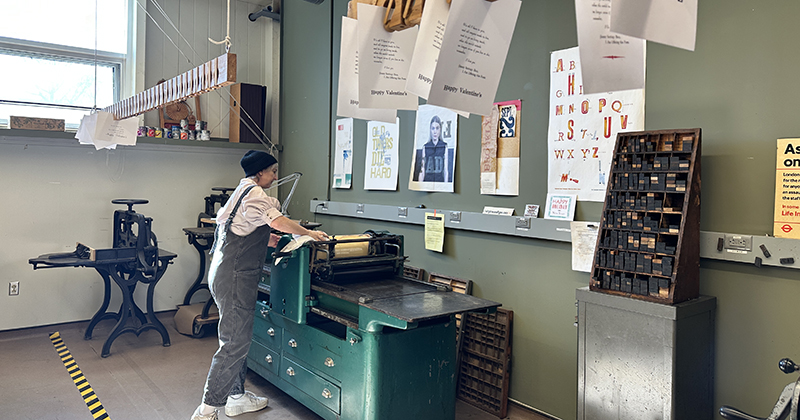
From Ink to AI
Photos courtesy of Hilary Douwes and Laura Helton July 02, 2025
Exploring the history of how humans communicate helps students navigate the digital landscape
Can you identify the innovations that changed history in the years 1440, 1927, 1991 and 2004?
The answers: Gutenberg’s printing press, the first television transmission, public access to the world wide web and the launch of Facebook. All altered how we communicate with each other.
Humanity is facing another watershed moment after the wide release of OpenAI’s ChatGPT in late 2022.
Using the past to understand the present is what UD students in Laura Helton’s ENGL480: From Ink to AI: Literature in the Makerspace course did. By writing with quill pens, binding books, marbling paper and examining digital adaptations, students explored how these technological developments shaped communication and literature.
“By looking at the history of writing technologies, and how these technologies have transformed cultural expression over time, our digital-age students could think about how they are shaped by today’s digital technologies,” said Helton, associate professor in the Department of English.
And, thanks to University of Delaware’s little-known Raven Press, Helton’s students also gained hands-on experience with a letterpress – the printing technology that dominated communication for more than 500 years.
The Raven Press
In the early 2000s, when digital printing had become commonplace, companies across the country began dismantling and disposing of their outdated letterpress equipment. Faculty from the Department of Art and Design salvaged what they could, establishing Raven Press in 2003 with an 1882 hand press, two 20th-century letterpresses and more than 2500 individual pieces of type.
As a campus Makerspace, Raven Press inspired art and design students for almost two decades, but fell dormant in 2020. Helton and Katie Leech, assistant professor of art and design, partnered to open the press for Helton’s class, as well as a Valentine’s Day card-making event in February that was open to the entire campus community.
When Leech joined UD in 2023, she was charged with restoring Raven Press, sorting, cleaning and repairing equipment, and bringing everything back to full working condition. The once dominant technology is now a niche artistic process, but students can learn a lot from operating a letterpress.
“The printing press is so powerful because it was the beginning of mass publication, and this caused massive changes, for example, to religion, as people could print and post flyers stating their beliefs,” Leech said.
She explained that the letterpress is a valuable tool for teaching modern typographic typesetting, offering a physical and visual way to understand concepts still used in digital design. Terms like 'leading'—which comes from the strips of lead once used to space lines—originated in letterpress and remain central to typography.
“People forget that a letter is just a symbol—nothing more. We've been taught to connect that symbol to content and meaning. But when a designer or artist recognizes letters as abstract visual forms, they can begin to use them expressively,” she said.
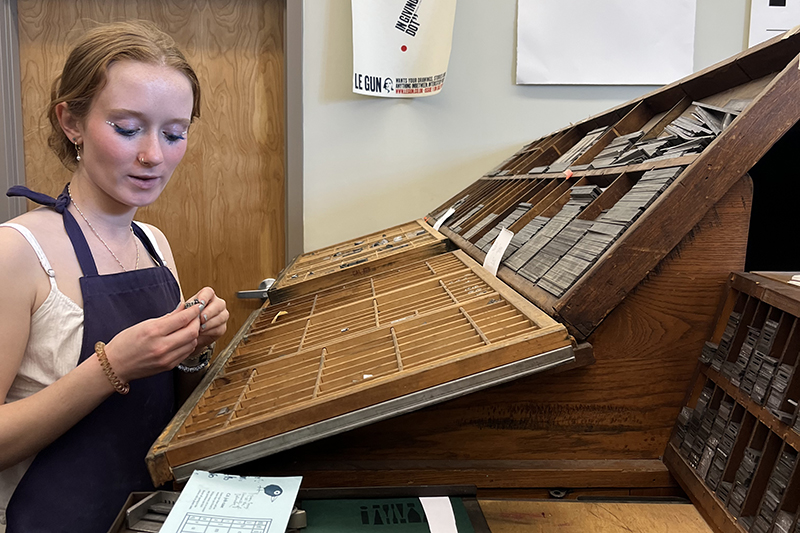
Before the keyboard
Using a letterpress is a commitment. The process includes selecting pieces of type - letters or designs - placing them on the press, applying ink, placing the paper, and then pulling a roller over the paper to press the ink. The goal is to achieve a “perfect kiss,” where the roller glides lightly over the type. Too light, and the ink won’t transfer. Too heavy, and it damages the type.
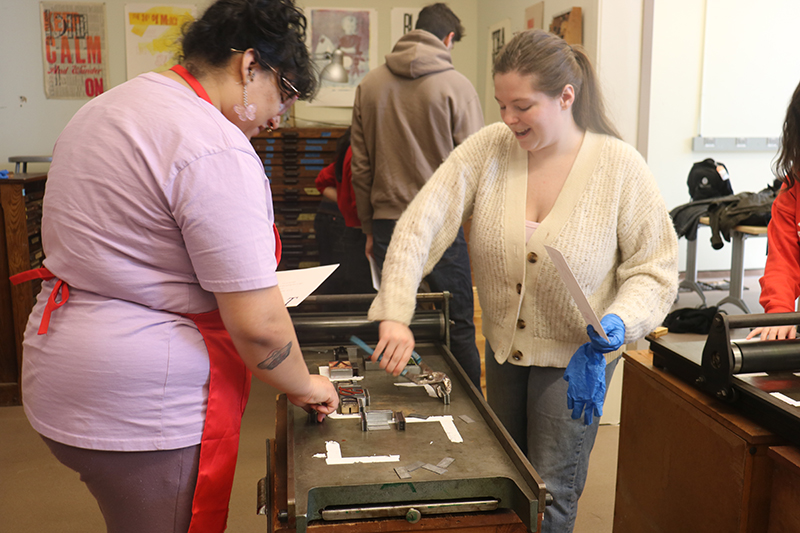
“It’s a beautiful dance between clarity and imperfection—making the type legible while also allowing the marks of the process to come through. These 'mistakes'—like scratches or indents from repeated use—create a unique, expressive image,” Leech said.
Sophomore art conservation major Rowan Dominick worked at the press last semester, helping Leech sort tiles. At the Valentine’s Day event, Dominick helped students achieve the “perfect kiss.”
“I like the physical process of it. It makes it engaging,” said Dominick.
Sophomore Gia Joella, a double major in political science and communication with minors in journalism and theater studies, said the process made her understand how difficult it was for people to get the word out.
“It made me appreciate how technology has advanced, because I can’t imagine having to do that every single time. Now, I just get to yank my laptop out,” she said.
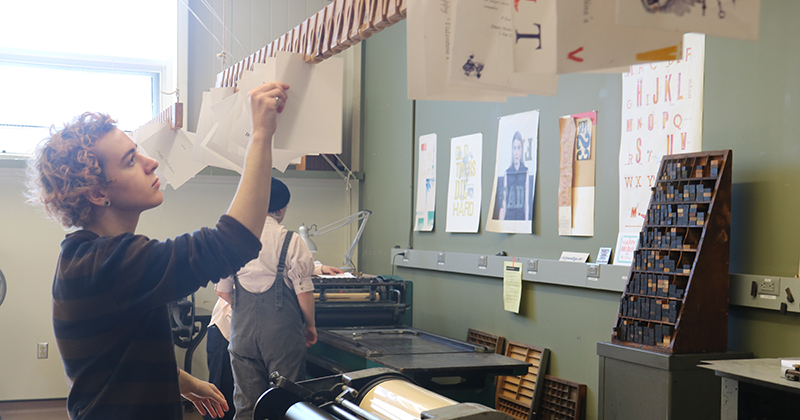
Creating and making mistakes, together
Running the letterpress also teaches students the importance of creative experimentation, of patience and of making mistakes.
“The students have to try multiple times to get things to look the way they want. They’re talking to each other about it. They’re laughing about it. They’re helping each other and teaching each other in real time,” Helton said.
For senior English major Cami Zabowski, who took the class with Helton, the process was more satisfying than typing.
“We built the words ourselves, picking through boxes to find the letters. It was a much longer but much more rewarding process. Seeing the finished product, it was like, wow, we actually made something. I don’t think you get the same satisfaction from just typing,” said Zabowksi, who uses they/them pronouns.
Zabowski also values having to use their hands to create the message. “I think tactile interaction with things really helps your brain make connections,” they said. “I used to doodle in class all the time to help me focus. And there are so many studies on the benefits of physically taking notes as opposed to typing them.”
Senior honors biochemistry major and forensics science minor Cassidy Driscoll attends creative events across campus as a way to break up study time and cope with stress. She said Raven Press was different because it wasn’t something she could do on her own.
“It was cool to do this thing most people wouldn’t have done,” she said.
“Students are craving these kinds of social and tactile opportunities,” Helton said. “That’s why makerspaces are popular across campus. Students need hands-on ways to experiment with their ideas.”
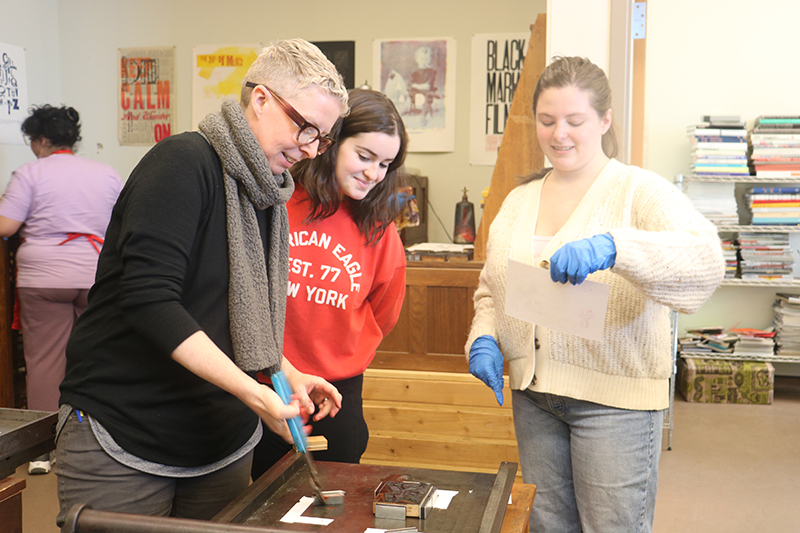
Expanding thought
Today’s students will never remember the time before we had access to instant information or the ability to debate issues in real time with people we will never even meet face-to-face, and future generations may never experience a world without artificial intelligence.
But Helton and Leech want students to understand how Gutenberg’s printing press was as revolutionary in 1440 as ChatGPT was in 2022.
“It is the backbone of reading and communication in the modern world,” Helton said. “As printing technology got faster and cheaper, it facilitated greater literacy in populations.”
We don’t yet know the scope of changes that digital technology and AI will bring, but Helton hopes learning about printing technology and creating with Raven Press inspires students to think about how they consume information and how they respond to changes in the world around them.
“Our moment feels extraordinary, but it is part of a longer history,” she said.
Contact Us
Have a UDaily story idea?
Contact us at ocm@udel.edu
Members of the press
Contact us at mediarelations@udel.edu or visit the Media Relations website

